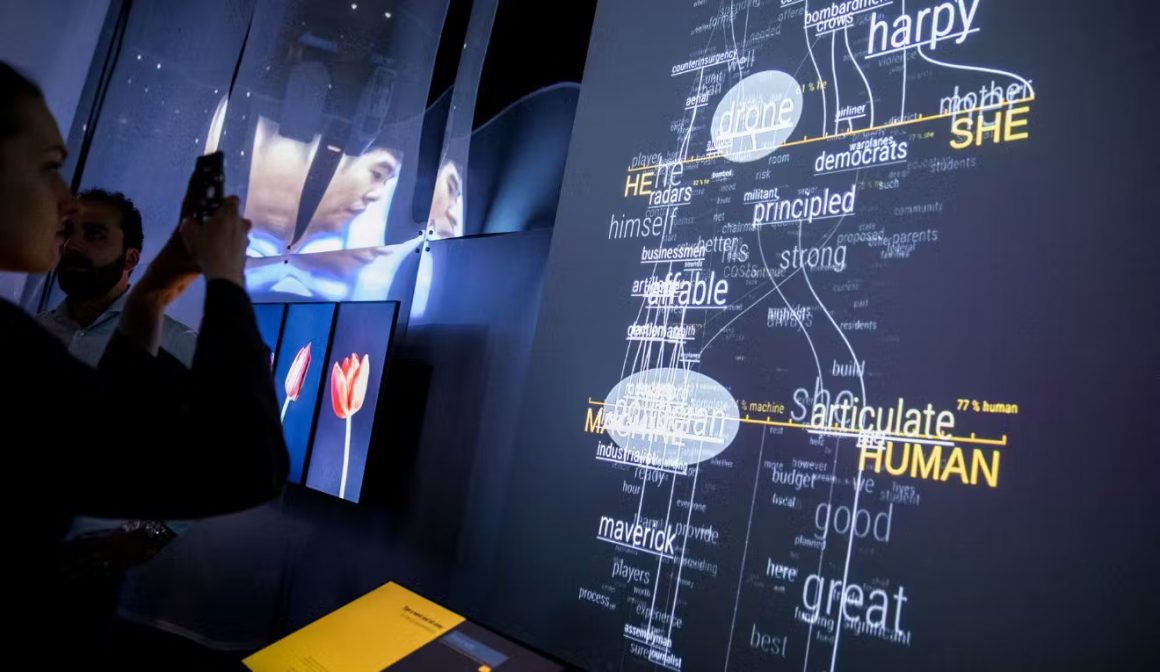
Telus Spark’s new exhibit “AI: More than Human” expands on AI’s capabilities
By Hannah Caparino, July 4 2024—
Beginning on June 1, Telus Spark has implemented a new exhibit titled, “AI: More than Human”. Calgarians can visit the new exhibit which will explore humanity’s relationship with AI. The exhibit includes digital installations and interactive sections for people to discover the extent of AI’s potential. One of the main goals of the exhibit is to promote introspective questions that will expand people’s knowledge on AI.
The exhibit begins by providing brief origins of AI, contextualizing what would be considered as artificial life. Primarily engaging with Japanese Shintoism, the exhibit emphasized how artificial life was based on the idea of implementing human-like qualities onto inanimate objects and utilising divine-like forces in everyday life. Shintoism had established a reciprocal and coexisting relationship between the development of society and technology. Alongside AI’s theoretical origins, “AI: More than Human” explores how AI had been developed from various mathematical systems and algorithms in the section titled “Numerical Systems”.
The timeline of AI’s creation was a major focus of the exhibit, explaining AI’s creation and execution in multiple eras. Beginning with “Incubation” (1800–1956), AI and artificial technology wasn’t a practical tool but a growing topic of discussion during the late industrial period to the early 20th century. “The Golden Age” (1956–1973) saw the growth of AI’s capabilities as technology became more advanced. It was during this era that Marvin Minsky’s work with AI and robotics would influence systems like ARPANET (Advanced Research Projects Agency Network) which would create the foundations for modern day internet. Following the “Golden Age” is “The First AI Winter” (1974–1980) and “Expert Systems and ARPANET” (1980–1987), and it saw the implementation of expert systems to solve complex problems through collecting data. “The Second AI Winter” (1988–1993) introduced Verner Vinge’s article about the “Technological Singularity”, highlighting a reality where technology and AI will surpass human knowledge. The timeline concludes with “The New Golden Age” (1994 – 2022) where it explains humanity’s gradual, but growing reliance on AI; examples being the introduction of SIRI, ALEXA and ChatGPT.
“AI: More than Human” uses interactive sections to expand on both AI’s uses and dangers. Visitors can interact with various ChatBots like E.L.I.Z.A, or play the game Rubedo to test AI’s predictability feature and its knowledge bank. Some activities that are labelled “You and AI” explore human behaviour in relation to AI technology. Algorithms and AI can use an individual’s personal information to better understand their health, or filter their likes and dislikes to find a compatible partner.
Although the exhibit promotes AI as a positive tool, it also reveals AI’s complicated conversation with ethics. One activity asks visitors to separate human writing samples from AI writing samples, and the ability to separate one from the other becomes increasingly difficult for those who are unaware of the identifiable patterns that AI programs like Heliograf and Quakebot use. The use of AI in journalism and media can influence the credibility of a source and can increase the presence of misinformation in the media cycle.
AI has also displayed forms of racial and gender bias, with multiple facial recognition programs correctly identifying lighter skinned individuals while marking people of colour as indistinguishable from one another. The exhibit features Joy Buolamwini’s videos like “Gender Shades” and “AI, Ain’t I a Woman?”, to expose AI’s mistakes in its racial and gender recognition software. AI’s development is also creating further complications regarding worldwide conflicts, explaining how AI technology is being utilized to inflict violence . The limitations of AI and warfare are endless and campaigns like Stop Killer Robots will ensure control and impose limitations when integrating AI in new weapons and technology.
Although the exhibit promotes AI as an assistive tool, AI as a system is continuing to advance alongside humanity’s understanding of artificiality. Telus Spark partnered with Barbican Centre to curate the exhibit alongside The City of London Corporation and the Groninger Forum to bring “AI: More than Human” to Calgary. To find out more about the exhibit or buy tickets, readers can check the Telus Spark website.
